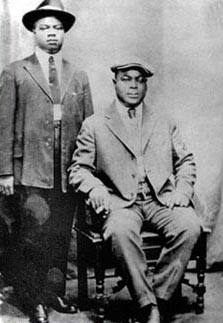
Louis Armstrong and Joe 'King' Oliver. Photo courtesy neajazzintheschools.org.
Most often we think of art as something created by a lone individual working far away from the social whirl. Painters, sculptors, poets and novelists almost always work alone. Their art is their own creative expression.
It’s different for musicians; they almost always produce their art in a group. And, jazz artists are a breed apart. Not only do they perform together, they also often create their music together through group improvisation—on the spot. Jazz artists don’t even need to speak the same language to communicate; jazz is their language.
On this edition of Riverwalk Jazz, we look at fascinating partnerships in jazz history, such as the collaboration between Louis Armstrong and King Oliver, or the musical camaraderie between saxophonist Lester Young and jazz singer Billie Holiday. We explore the special partnership between composer and lyricist in the work of songwriting teams like Rodgers and Hart or Fats Waller and Andy Razaf. And, we pay tribute to great jazz-inspired partnerships as in the celebrated Rogers and Astaire dance team.
.gif)
Eddie Lang. Photo courtesy of redhotjazz.
The first music set on this broadcast derives from the unique jazz partnership of Armstrong and Oliver; a relationship so close it was almost like father and son. Our interpretation of “Snake Rag“ begins with the actual 1923 historical recording then crossfades into a live performance by Jim Cullum and the Band with Chicago tuba player Mike Walbridge and Bay Area cornet man Leon Oakley on stage at The Landing. “Camp Meeting Blues,” composed by King Oliver, comes from the same landmark 1923 recording session at the Gennett Studio in Richmond, Indiana. Walbridge and Oakley sit in with The Jim Cullum Jazz Band on our rendition of “Camp Meeting Blues” heard here.
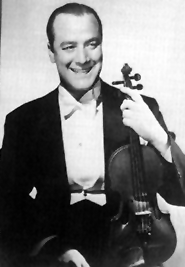
Joe Venuti. Photo courtesy of redhotjazz.
Joe Venuti and his boyhood pal Eddie Lang had a lifelong friendship and a rich musical partnership. They met in 1913 as school kids in Philadelphia. A scant three years later, they formed a musical group together. Joe Venuti would become the first widely celebrated jazz violinist, and Eddie Lang the first jazz guitar virtuoso to break through to mainstream success. Together, Venuti and Lang created a new sound in jazz. Their contribution was the high point on a number of mainstream recordings issued in the late 1920s on the Victor label under the name the Joe Venuti Blue Four; and the Venuti/Lang duo was featured on numerous commercial dance band recordings of the era.
Our tribute to Joe Venuti and Eddie Lang is the performance of Venuti’s original composition “Beatin' the Dog“ heard here with New York player Andy Stein on hot fiddle and the avatar of the acoustic guitar Marty Grosz. This number is followed by another title from Venuti/Lang called “Pretty Trix” showcasing bass saxophonist Vince Giordano with members of The Jim Cullum Jazz Band.
.jpg)
"Ain't Misbehavin" sheet music, 1929. Image courtesy songbook1.wordpress.
It’s impossible to talk about famous jazz partnerships without mentioning piano man Fats Waller and his songwriting partner Andy Razaf. Razaf was a ten-year-old boy living in Washington, DC in 1905 when he first began to write poetry. Fats Waller was still a baby in diapers in New York City and his musical genius had yet to be revealed. The duo met in 1921. Andy Razaf came up to Fats on a Harlem street corner shortly after Waller had won a local piano competition, and introduced himself. Razaf had calculated that Waller would be feeling good after the win, and open to being approached by a stranger.
Seven years later, the pair had a monster hit on Broadway. Their score for Hot Chocolates included two huge songs: “Ain’t Misbehavin’” and “Black and Blue.” Together, Waller and Razaf wrote a string of enduring pop hits, “Honeysuckle Rose,” “Keeping Out of Mischief” and “Squeeze Me,” among many others.
In just one week in Fall 1937, the Waller-Razaf duo wrote six songs including “The Joint is Jumpin,'“ presented here in another mash-up, crossfade from the original historical recording (for which Waller and Razaf got their friends together to make the session sound like a Harlem rent party about to be raided by the cops) to the live performance on stage at The Landing spotlighting Dick Hyman and John Sheridan on grand pianos with the rest of The Jim Cullum Jazz Band.
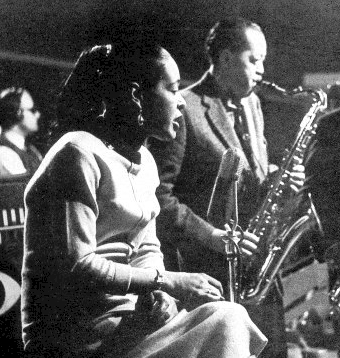
Lester Young and Billie Holiday, 1957. Photo courtesy of New York Public Library.
If there were ever soulmates of song, Billie Holiday and Lester Young would be at the top of the list. “Lady Day” and “Prez” were close friends. Musically, they seemed to communicate on a soulful, almost telepathic level bypassing the need for words. Together in the late 1930s and early ‘40s, they made a series of poignant recordings, among them “Travelin’ All Alone” and “The Man I Love.” On this salute, singer Topsy Chapman recalls the Young/Holiday partnership with another one of their favorites— “He's Funny That Way.“
Though the songwriting team of Richard Rodgers and Lorenz Hart composed their music for stage plays and Hollywood musicals, jazz musicians have always gravitated to their material and adapted it for jazz band stylings. The Rodgers and Hart collaboration began in 1919 when both were students at Columbia University. Rodgers was only sixteen when a mutual friend introduced him to the much older Hart because he hoped they’d work well together on an upcoming college theatrical production. Five years later, Rodgers and Hart won their first break on Broadway with the score for the Garrick Gaieties.
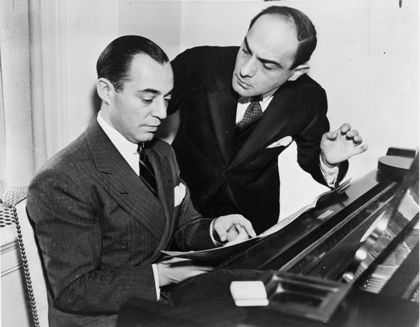
Richard Rodgers and Lorenz Hart. Photo courtesy of Columbus-Lowndes Public Library.
It’s been said that Rogers and Hart wrote their songs quickly and never seemed to take a break. Over the course of their 20-year partnership, the pair wrote more than 550 songs for twenty-eight shows and eight movies. The combination of Hart’s witty lyrics and Rodgers’ transparent melodies make their songs fresh and vital today more than a half-century after they were written.
Our version of “You Took Advantage of Me“ opens with a half-chorus of bassist Don Mopsick playing the melody, followed by Jim and the Band with Brian Ogilvie on tenor sax. Rodgers and Hart created the tune for a 1928 stage show, called Present Arms. Our version of “This Can't Be Love“ by Rodgers and Hart features the Australian songstress Nina Ferro, while “Blue Moon“ is taken at a medium bounce tempo typical of the 1930s and features San Francisco guitarist Paul Mehling.
In 1935, hordes of moviegoers lined up to see the elegant and always graceful Fred Astaire in a top and tails glide effortlessly across a dance floor with Ginger Rogers in his arms. The movie of the moment was RKO’s Top Hat. The score was by Irving Berlin and “Cheek to Cheek“ was nominated for an Academy Award. On this broadcast, jazz singer Rebecca Kilgore takes the vocal, joining Jim Cullum and the Band to salute the mesmerizing dance team ‘Fred and Ginger,’ a couple with swing rhythm in all their moves.
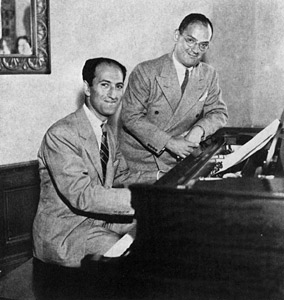
George and Ira Gershwin. Photo courtesy of oldglobe.org.
Every piece George and Ira Gershwin wrote had a jazz feeling to it. They composed music for Tin Pan Alley, the Broadway stage and the movies. They even wrote a folk opera. Every bit of their music has been picked up and played by jazz musicians. George and Ira had an interesting working style. As the brothers worked away at the piano, the rest of the Gershwin family would often be in the same room playing cards, reading the newspaper or having lunch and chatting away.
One day George played a simple musical phrase for Ira so they could get started on a new song. It was a single note repeated four times, but in an unusual rhythmic pattern. Ira asked George to come up with two more notes so he could use a phrase that had been rolling around in his head—The way you wear your hat. A few hours later the result was the sweet/sad love song, “They Can't Take That Away From Me.“ Here, stage and movie actor Carol Woods joins The Jim Cullum Jazz Band on vocals. Pianists Dick Hyman and John Sheridan present the Gershwin’s “Fascinating Rhythm“ with the Cullum Band, in an original arrangement created by George Gershwin himself to perform on a radio broadcast.
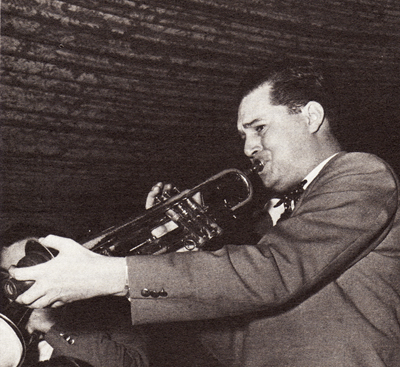
Trumpeter Yank Lawson. Photo courtesy of Jim Cullum, Jr.
Composer and bassist Bob Haggart teamed up with trumpeter Yank Lawson in the mid-1930s as founding members of the Bob Crosby Orchestra. They went on to make a series of important recordings and worked together in various ensembles for close to fifty years. We captured Bob and Yank live at The Landing one night in 1989, playing one of Haggart’s most enduring hit songs, “What’s New?” followed by their duo rendition of Charlie Chaplin’s “Smile,” a tune they enjoyed playing together in their later years.
Photo credit for Home Page: "Cheek To Cheek" sheet music. Image courtesy flickerriver.com.
Text based on Riverwalk Jazz script by Margaret Moos Pick ©2002

